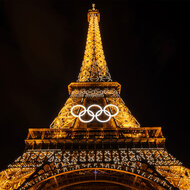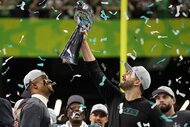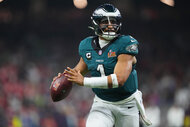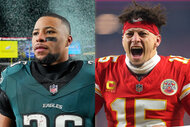Flag Football to Make Its Olympic Debut at the 2028 Los Angeles Games (DETAILS)
N.F.L. legends Patrick Mahomes and Rob Gronkowski are just a few big names to show interest in the no-contact sport.
The not-so-new sport of flag football is making a touchdown in the Olympics, but spectators will have to wait a few more years after the Paris 2024 Summer Games.
In October 2023, the International Olympic Committee (I.O.C.) approved the no-contact sport, along with squash, to debut at the Los Angeles Summer Olympics 2028. The decision by the I.O.C.’s 141st session came when flag football was pitched as part of a proposed five-sport package, which also included the return of lacrosse, cricket, and (combined) baseball and softball, all of which were approved.
The significance of these sports being introduced (or returning) to the Olympic Games, according to L.A. Chairman Casey Wasserman, was that they were “relevant, innovative, and community-based, played in backyards, schoolyards, community centers, stadiums, and parks across the U.S. and the globe,” The Associated Press reported.
Flag football — once called “Tough and Tail Football” — originated as a recreational sport amongst U.S. soldiers during WWII, according to the Olympics’ official page. The first-known games were said to have taken place at Maryland’s Fort Meade.
Keep reading to learn more about flag football and why it’s gained popularity ever since.
What are the rules of flag football?
Unlike North American or gridiron football, flag football requires no contact, making injuries far less common. Instead of traditional tackles, players earn points by removing one of three flags hanging from the waist of a ball-carrying opponent — one flag is attached at either side of the player and another at the back, according to the Olympics page.
“Tackles” include diving, kicking, blocking, screening, and fumbles, according to the rules listed on Gridiron Football.
The pitch is also smaller than traditional football fields to accommodate smaller-sized teams. Per the Olympic rules, a flag football pitch measures 70 by 30 yards, with 10 yards saved for the end zones. Gridiron football, however, measures 120 by 53.3 yards with 10-yard end zones at each side.
Five-player flag football teams are selected from 12-person squads to make up the game’s offense and defense. Games consist of two 20-minute halves, with the starting team beginning at its own five-yard line.
The offense gets four plays (or downs) to reach midfield. On their third attempt, according to the N.F.L.’s flag football rules, players have the option of either punting (which permits the other team to take the ball to their own five-yard line and try the same), or the starting team can make their final attempt. However, if the offense does cross the midfield within four tries, they have four more downs to reach the end zone and make a touchdown.
“After a touchdown, worth six points, teams go for an extra point — by running or passing — from the five-yard line, or two extra points from the 10-yard line,” according to the Olympics’ rules.
A sudden-death challenge is presented if both teams are tied at the end of the 40-minute game.
Can both men and women play flag football?
While gridiron football is a predominately male sport, flag football is open to a fair mix of both men and women. The game especially grew in popularity among female high school athletes in 2010 and became a sanctioned sport among female college athletes by the National Association of Intercollegiate Athletics (N.A.I.A.) in 2020, according to the N.F.L.
Vanita Krouch, quarterback for the U.S. Women’s National Team and self-styled as “The Tom Brady of Flag Football,” expressed her enthusiasm at the decision to introduce the sport into the Olympic Games by calling it “a dream come true,” according to USA Football.
“Being a part of the Olympics in Los Angeles in 2028 is going to show the world what this sport is all about,” she said. “Flag football is so competitive, it’s so creative and it’s so inclusive. This is a sport for everyone – men and women, boys and girls – and this can be a dream come true for them too because now they can see that there’s a path for them to compete at the highest level.”
According to the Olympics’ official webpage, the women’s U.S. Team were two-time world champions before Mexico — cited as the U.S. team’s “biggest threat” — beat them in the 2022 World Games.
As for the males, quarterback Darrell “Housh” Doucette led the men’s U.S. Team to victory in the 2022 World Games, marking their fourth consecutive title, according to the Olympics. In his response to flag football’s entering the Games in 2028, he said he was “so happy,” especially “for the younger players coming up that can see that they have the chance to represent the U.S. in their sport,” as reported by USA Football.
Italy, Canada, and Austria also regularly compete.
Patrick Mahomes, Rob Gronkowski, and more express interest
Players from the N.F.L. will seemingly be eligible to play flag football in the 2028 Summer Olympic Games in L.A., at least according to early reports.
Kansas City Chiefs quarterback and N.F.L. M.V.P. Patrick Mahomes is one of the several top names to have expressed interest in flag football as an Olympic sport, he revealed at a Frankfurt, Germany, press conference in November 2023.
“I think it’s really cool because football is a great game that has given me so much, and I want to make sure everyone gets the same experience that I got growing up,” said Mahomes, adding that some flag footballers were “a little faster" than him.
Former N.F.L. tight end Rob Gronkowski and current Miami Dolphins wide receiver Tyreek Hill have also expressed interest in playing the sport, according to NBC Sports.
The N.F.L., noting that flag football has reached over 100 countries, is a proud supporter of the sport, according to N.F.L. Football Operations’ Executive Vice President Troy Vincent Sr. The league also places great emphasis on flag football among the youth.
“When we talk about the future of the game of football, it is, no question, flag,” he said. “When I’m asked what the next 100 years looks like when you look at football, not professional football, it’s flag. It’s the inclusion and the true motto of ‘football for all.’ There is a place in flag football for all.”
N.F.L. Commissioner Roger Goodell called the Olympics’ approval of flag football “a tremendous honor,” one he hoped could “inspire millions of young people around the world,” according to NBC Sports.
“The N.F.L. is committed to working together to strengthen flag football’s place in the Olympic movement long term, and we look forward to continuing this exciting journey with I.F.A.F. [The International Federation of American Football], the LA28 Organizing Committee, the International Olympic Committee, and U.S.A. Football.”
The organization’s is the N.F.L.’s official – and largest — flag football league for youths aged 4 to 17 in the U.S.






















